SKODA FABIA 2014 2.G / 5J Owner's Manual
Manufacturer: SKODA, Model Year: 2014, Model line: FABIA, Model: SKODA FABIA 2014 2.G / 5JPages: 197, PDF Size: 13.56 MB
Page 151 of 197
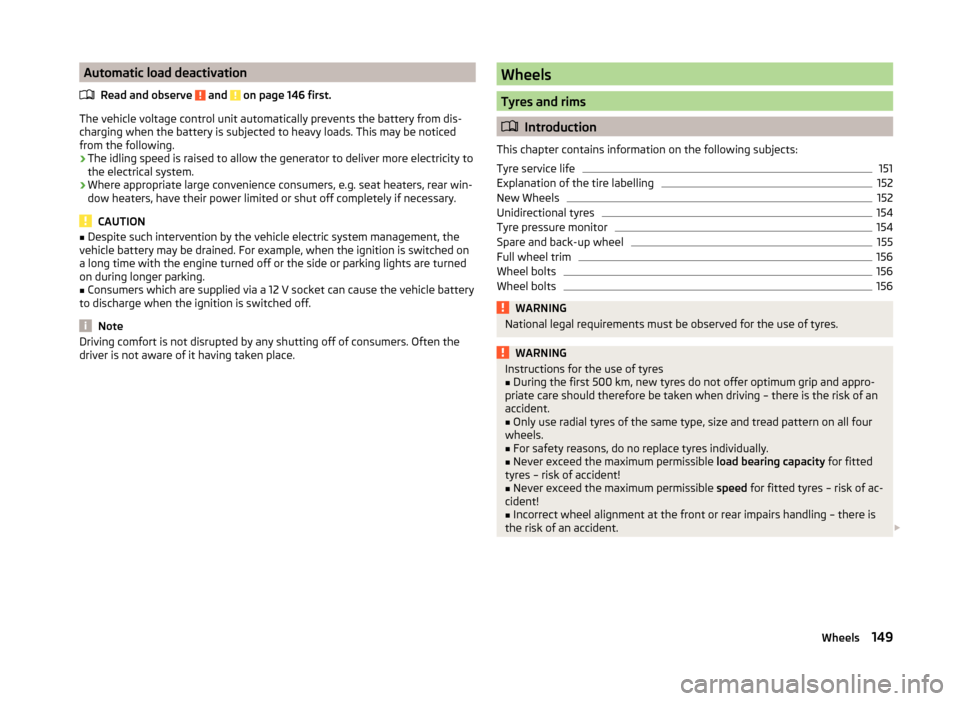
Automatic load deactivationRead and observe
and on page 146 first.
The vehicle voltage control unit automatically prevents the battery from dis-
charging when the battery is subjected to heavy loads. This may be noticed
from the following.
› The idling speed is raised to allow the generator to deliver more electricity to
the electrical system.
› Where appropriate large convenience consumers, e.g. seat heaters, rear win-
dow heaters, have their power limited or shut off completely if necessary.
CAUTION
■ Despite such intervention by the vehicle electric system management, the
vehicle battery may be drained. For example, when the ignition is switched on
a long time with the engine turned off or the side or parking lights are turned
on during longer parking.■
Consumers which are supplied via a 12 V socket can cause the vehicle battery
to discharge when the ignition is switched off.
Note
Driving comfort is not disrupted by any shutting off of consumers. Often the
driver is not aware of it having taken place.Wheels
Tyres and rims
Introduction
This chapter contains information on the following subjects:
Tyre service life
151
Explanation of the tire labelling
152
New Wheels
152
Unidirectional tyres
154
Tyre pressure monitor
154
Spare and back-up wheel
155
Full wheel trim
156
Wheel bolts
156
Wheel bolts
156WARNINGNational legal requirements must be observed for the use of tyres.WARNINGInstructions for the use of tyres■During the first 500 km, new tyres do not offer optimum grip and appro-
priate care should therefore be taken when driving – there is the risk of an
accident.■
Only use radial tyres of the same type, size and tread pattern on all four
wheels.
■
For safety reasons, do no replace tyres individually.
■
Never exceed the maximum permissible load bearing capacity for fitted
tyres – risk of accident!
■
Never exceed the maximum permissible speed for fitted tyres – risk of ac-
cident!
■
Incorrect wheel alignment at the front or rear impairs handling – there is
the risk of an accident.
149Wheels
Page 152 of 197
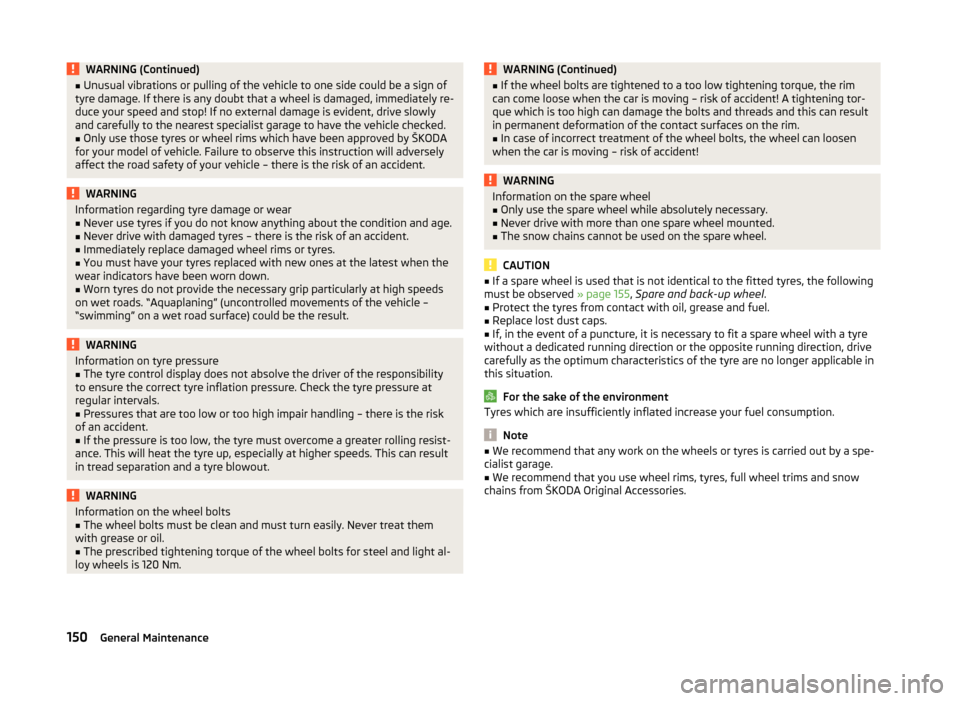
WARNING (Continued)■Unusual vibrations or pulling of the vehicle to one side could be a sign of
tyre damage. If there is any doubt that a wheel is damaged, immediately re-
duce your speed and stop! If no external damage is evident, drive slowly
and carefully to the nearest specialist garage to have the vehicle checked.■
Only use those tyres or wheel rims which have been approved by ŠKODA
for your model of vehicle. Failure to observe this instruction will adversely
affect the road safety of your vehicle – there is the risk of an accident.
WARNINGInformation regarding tyre damage or wear■Never use tyres if you do not know anything about the condition and age.■
Never drive with damaged tyres – there is the risk of an accident.
■
Immediately replace damaged wheel rims or tyres.
■
You must have your tyres replaced with new ones at the latest when the
wear indicators have been worn down.
■
Worn tyres do not provide the necessary grip particularly at high speeds
on wet roads. “Aquaplaning” (uncontrolled movements of the vehicle –
“swimming” on a wet road surface) could be the result.
WARNINGInformation on tyre pressure■The tyre control display does not absolve the driver of the responsibility
to ensure the correct tyre inflation pressure. Check the tyre pressure at
regular intervals.■
Pressures that are too low or too high impair handling – there is the risk
of an accident.
■
If the pressure is too low, the tyre must overcome a greater rolling resist-
ance. This will heat the tyre up, especially at higher speeds. This can result
in tread separation and a tyre blowout.
WARNINGInformation on the wheel bolts■The wheel bolts must be clean and must turn easily. Never treat them
with grease or oil.■
The prescribed tightening torque of the wheel bolts for steel and light al-
loy wheels is 120 Nm.
WARNING (Continued)■ If the wheel bolts are tightened to a too low tightening torque, the rim
can come loose when the car is moving – risk of accident! A tightening tor-
que which is too high can damage the bolts and threads and this can result
in permanent deformation of the contact surfaces on the rim.■
In case of incorrect treatment of the wheel bolts, the wheel can loosen
when the car is moving – risk of accident!
WARNINGInformation on the spare wheel■Only use the spare wheel while absolutely necessary.■
Never drive with more than one spare wheel mounted.
■
The snow chains cannot be used on the spare wheel.
CAUTION
■ If a spare wheel is used that is not identical to the fitted tyres, the following
must be observed » page 155, Spare and back-up wheel .■
Protect the tyres from contact with oil, grease and fuel.
■
Replace lost dust caps.
■
If, in the event of a puncture, it is necessary to fit a spare wheel with a tyre
without a dedicated running direction or the opposite running direction, drive
carefully as the optimum characteristics of the tyre are no longer applicable in
this situation.
For the sake of the environment
Tyres which are insufficiently inflated increase your fuel consumption.
Note
■ We recommend that any work on the wheels or tyres is carried out by a spe-
cialist garage.■
We recommend that you use wheel rims, tyres, full wheel trims and snow
chains from ŠKODA Original Accessories.
150General Maintenance
Page 153 of 197

Tyre service lifeFig. 133
Principle sketch: Tyre tread with wear indicators/Open fuel filler
flap with a table detailing the tyre sizes and tyre pressures
Fig. 134
Swapping wheels around
Read and observe and on page 149 first.
The life of tyres depends on the pressure, driving style, and other circumstan-
ces. Following the advice below can extend the service life of your tyres.
Tyre pressure
Check the tyre pressure, including that of the spare wheel, at least once a
month and also before setting off on a long journey.
The tyre pressures for tyres are shown on the inside of the fuel filler
flap » Fig. 133 –
.
The tyre pressure should be at the highest pressure specified for your vehicle
at all times.
Always check the inflation pressure when the tyres are cold. Do not reduce the
higher pressure of warm tyres.
Adjust the tyre pressure accordingly if you are carrying a greater load.
Driving style
Fast cornering, sharp acceleration and braking increase the wear of your tyres.
Balancing wheels
The wheels of a new vehicle are balanced. There are a wide range of influen-
ces when the car is being driven which may result in an imbalance. This may
become apparent by “vibration” in the steering.
Have the wheels rebalanced after replacing the tyres.
Wheel alignment errors
Incorrect wheel alignment at the front or rear leads to excess wear on the
tyres.
Tyre damage
Drive over kerbs and other such obstacles slowly and at right angles wherever
possible in order to avoid damage to tyres and wheel trims.
We recommend checking your tyres and wheel rims for damage (punctures,
cuts, splits and bulges, etc.) on a regular basis. Remove foreign bodies (e.g.
small stones) from the tyre profile immediately.
Swapping wheels around
If significantly greater wear is present on the front tyres, we recommend
swapping the front wheels with the rear wheels as shown in the dia-
gram » Fig. 134 . You will then obtain approximately the same life for all the
tyres.
We recommend that you swap the tyres around every 10,000 km in order to
achieve even wear on all tyres and to obtain optimal tyre life.
Storing tyres
Mark the tyres as you remove them so that you are able to refit them to run in
the same direction.
Always store wheels or tyres in a cool, dry and, where possible, dark place.
Tyres which are not fixed to a wheel trim should be stored upright.
Wear indicators
The base of the tread of the tyres has 1.6 mm high wear indicators installed. These wear indicators are arranged evenly spaced around the circumference of
the tyre a number of times depending on the make » Fig. 133 -
. Markings on
the walls of the tyres through the letters “TWI”, triangular symbols or other
symbols identify the position of the wear indicators. 151Wheels
Page 154 of 197
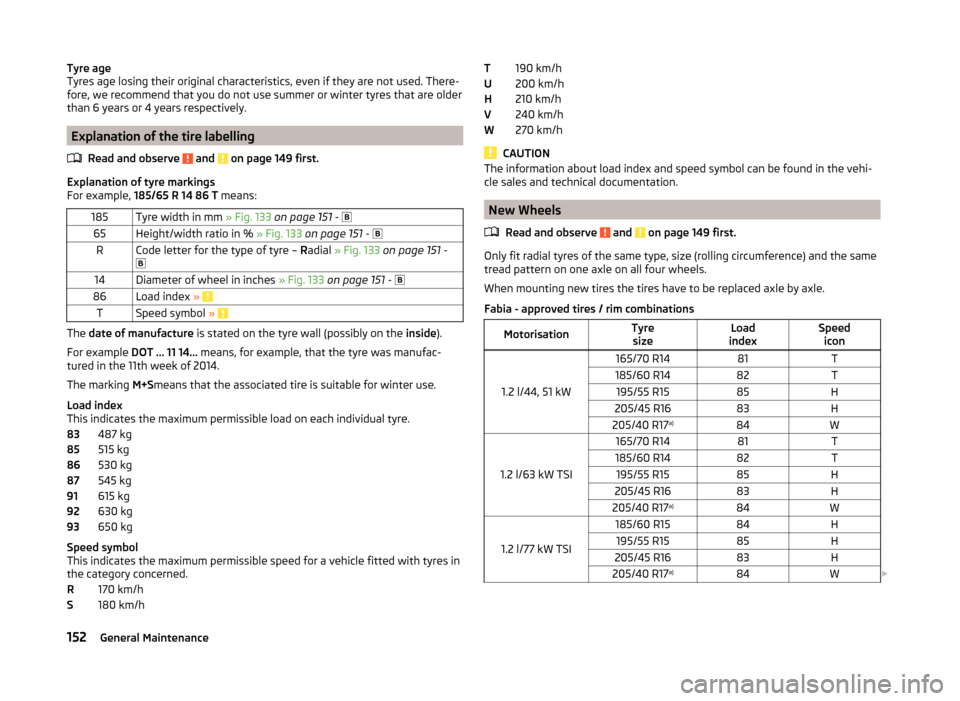
Tyre age
Tyres age losing their original characteristics, even if they are not used. There-
fore, we recommend that you do not use summer or winter tyres that are older
than 6 years or 4 years respectively.
Explanation of the tire labelling
Read and observe
and on page 149 first.
Explanation of tyre markings
For example, 185/65 R 14 86 T means:
185Tyre width in mm » Fig. 133 on page 151 - 65Height/width ratio in % » Fig. 133 on page 151 - RCode letter for the type of tyre – Radial » Fig. 133 on page 151 -
14Diameter of wheel in inches » Fig. 133 on page 151 - 86Load index » TSpeed symbol »
The date of manufacture is stated on the tyre wall (possibly on the inside).
For example DOT ... 11 14... means, for example, that the tyre was manufac-
tured in the 11th week of 2014.
The marking M+Smeans that the associated tire is suitable for winter use.
Load index
This indicates the maximum permissible load on each individual tyre.
487 kg
515 kg
530 kg
545 kg
615 kg
630 kg
650 kg
Speed symbol
This indicates the maximum permissible speed for a vehicle fitted with tyres in
the category concerned.
170 km/h
180 km/h
83858687919293RS190 km/h
200 km/h
210 km/h
240 km/h
270 km/h
CAUTION
The information about load index and speed symbol can be found in the vehi-
cle sales and technical documentation.
New Wheels
Read and observe
and on page 149 first.
Only fit radial tyres of the same type, size (rolling circumference) and the same
tread pattern on one axle on all four wheels.
When mounting new tires the tires have to be replaced axle by axle.
Fabia - approved tires / rim combinations
MotorisationTyre sizeLoad
indexSpeed icon
1.2 l/44, 51 kW
165/70 R1481T185/60 R1482T195/55 R1585H205/45 R1683H205/40 R17 a)84W
1.2 l/63 kW TSI
165/70 R1481T185/60 R1482T195/55 R1585H205/45 R1683H205/40 R17a)84W
1.2 l/77 kW TSI
185/60 R1584H195/55 R1585H205/45 R1683H205/40 R17a)84W
TUHVW152General Maintenance
Page 155 of 197
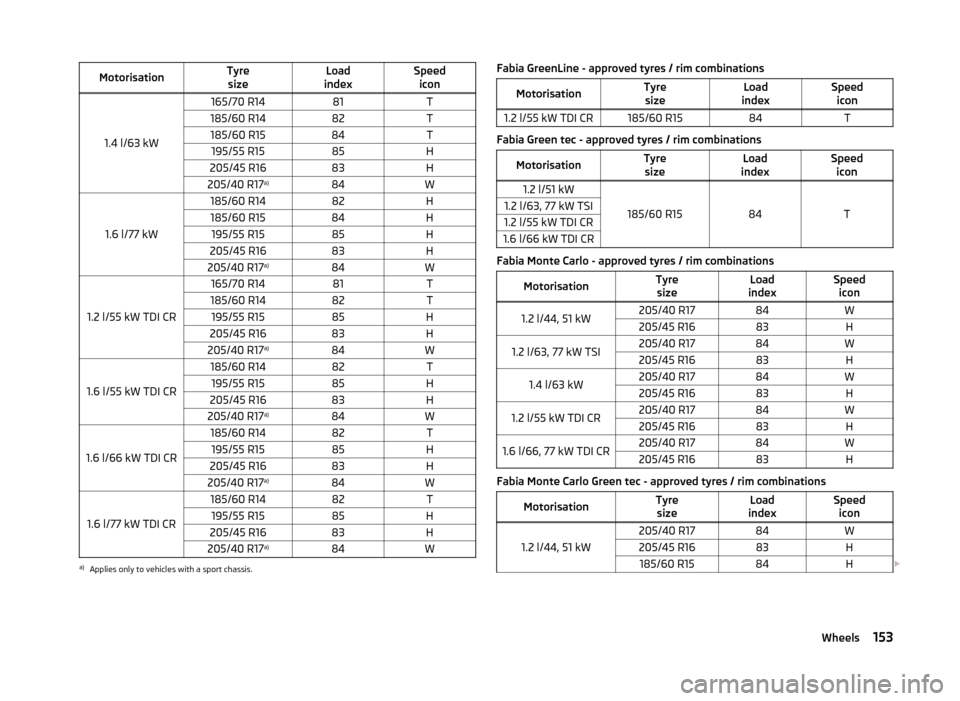
MotorisationTyresizeLoad
indexSpeed icon
1.4 l/63 kW
165/70 R1481T185/60 R1482T185/60 R1584T195/55 R1585H205/45 R1683H205/40 R17 a)84W
1.6 l/77 kW
185/60 R1482H185/60 R1584H195/55 R1585H205/45 R1683H205/40 R17a)84W
1.2 l/55 kW TDI CR
165/70 R1481T185/60 R1482T195/55 R1585H205/45 R1683H205/40 R17a)84W
1.6 l/55 kW TDI CR
185/60 R1482T195/55 R1585H205/45 R1683H205/40 R17a)84W
1.6 l/66 kW TDI CR
185/60 R1482T195/55 R1585H205/45 R1683H205/40 R17 a)84W
1.6 l/77 kW TDI CR
185/60 R1482T195/55 R1585H205/45 R1683H205/40 R17a)84Wa)
Applies only to vehicles with a sport chassis.
Fabia GreenLine - approved tyres / rim combinationsMotorisationTyre
sizeLoad
indexSpeed icon1.2 l/55 kW TDI CR185/60 R1584T
Fabia Green tec - approved tyres / rim combinations
MotorisationTyresizeLoad
indexSpeed icon1.2 l/51 kW
185/60 R1584T
1.2 l/63, 77 kW TSI1.2 l/55 kW TDI CR1.6 l/66 kW TDI CR
Fabia Monte Carlo - approved tyres / rim combinations
MotorisationTyresizeLoad
indexSpeed icon1.2 l/44, 51 kW205/40 R1784W205/45 R1683H1.2 l/63, 77 kW TSI205/40 R1784W205/45 R1683H1.4 l/63 kW205/40 R1784W205/45 R1683H1.2 l/55 kW TDI CR205/40 R1784W205/45 R1683H1.6 l/66, 77 kW TDI CR205/40 R1784W205/45 R1683H
Fabia Monte Carlo Green tec - approved tyres / rim combinations
MotorisationTyresizeLoad
indexSpeed icon
1.2 l/44, 51 kW
205/40 R1784W205/45 R1683H185/60 R1584H 153Wheels
Page 156 of 197
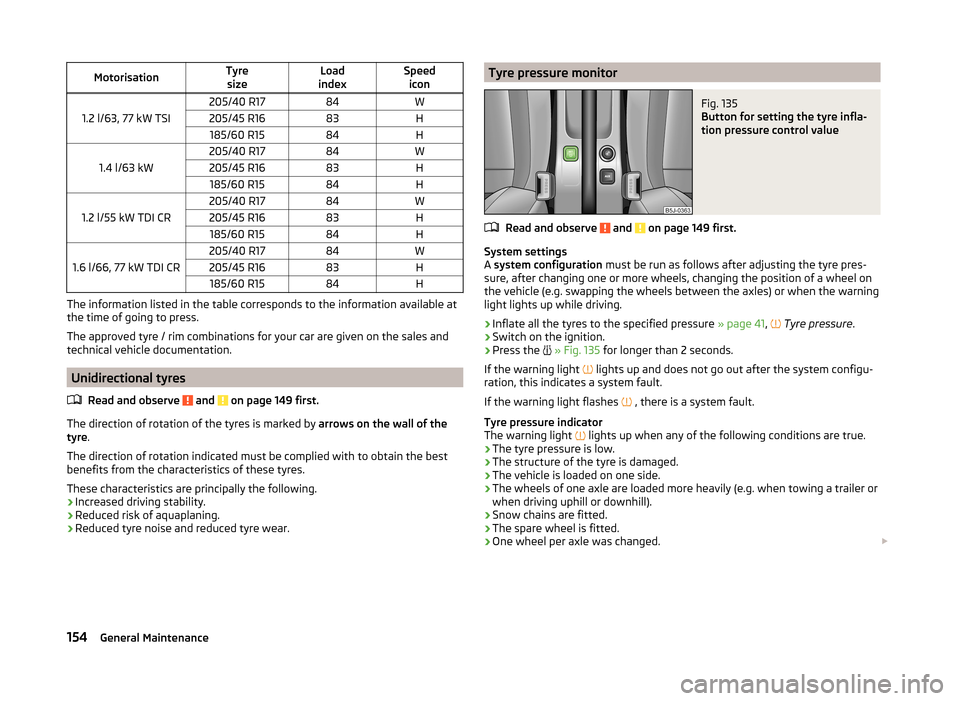
MotorisationTyresizeLoad
indexSpeed icon
1.2 l/63, 77 kW TSI
205/40 R1784W205/45 R1683H185/60 R1584H
1.4 l/63 kW
205/40 R1784W205/45 R1683H185/60 R1584H
1.2 l/55 kW TDI CR
205/40 R1784W205/45 R1683H185/60 R1584H
1.6 l/66, 77 kW TDI CR
205/40 R1784W205/45 R1683H185/60 R1584H
The information listed in the table corresponds to the information available at
the time of going to press.
The approved tyre / rim combinations for your car are given on the sales and
technical vehicle documentation.
Unidirectional tyres
Read and observe
and on page 149 first.
The direction of rotation of the tyres is marked by arrows on the wall of the
tyre .
The direction of rotation indicated must be complied with to obtain the best
benefits from the characteristics of these tyres.
These characteristics are principally the following.
› Increased driving stability.
› Reduced risk of aquaplaning.
› Reduced tyre noise and reduced tyre wear.
Tyre pressure monitorFig. 135
Button for setting the tyre infla-
tion pressure control value
Read and observe and on page 149 first.
System settings
A system configuration must be run as follows after adjusting the tyre pres-
sure, after changing one or more wheels, changing the position of a wheel on
the vehicle (e.g. swapping the wheels between the axles) or when the warning
light lights up while driving.
›
Inflate all the tyres to the specified pressure » page 41,
Tyre pressure
.
›
Switch on the ignition.
›
Press the
» Fig. 135 for longer than 2 seconds.
If the warning light lights up and does not go out after the system configu-
ration, this indicates a system fault.
If the warning light flashes , there is a system fault.
Tyre pressure indicator
The warning light lights up when any of the following conditions are true.
› The tyre pressure is low.
› The structure of the tyre is damaged.
› The vehicle is loaded on one side.
› The wheels of one axle are loaded more heavily (e.g. when towing a trailer or
when driving uphill or downhill).
› Snow chains are fitted.
› The spare wheel is fitted.
› One wheel per axle was changed.
154General Maintenance
Page 157 of 197
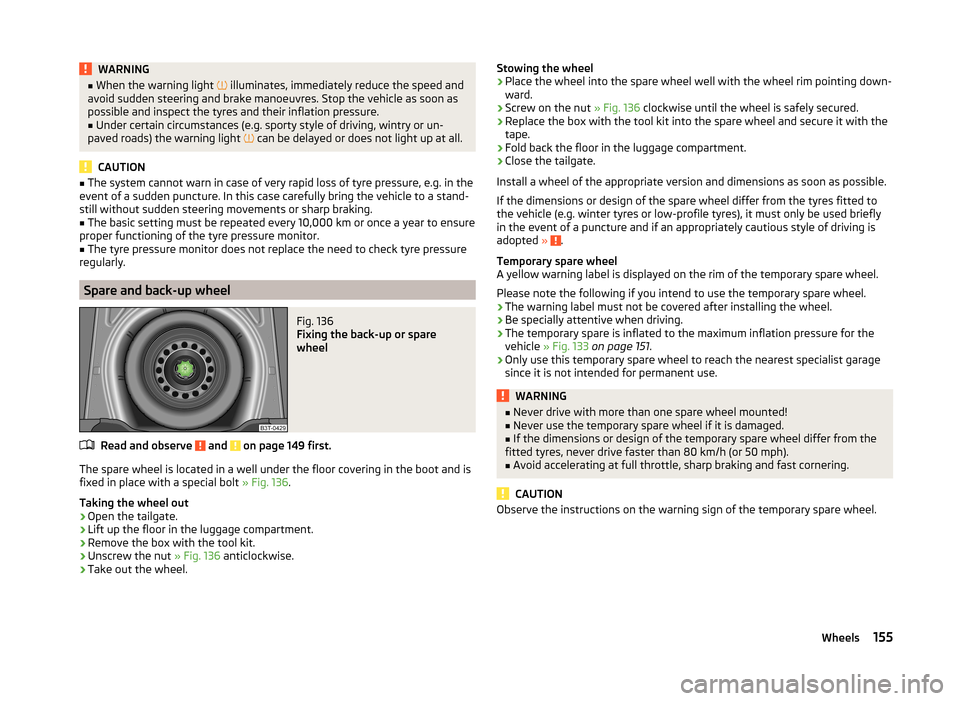
WARNING■When the warning light illuminates, immediately reduce the speed and
avoid sudden steering and brake manoeuvres. Stop the vehicle as soon as
possible and inspect the tyres and their inflation pressure.■
Under certain circumstances (e.g. sporty style of driving, wintry or un-
paved roads) the warning light
can be delayed or does not light up at all.
CAUTION
■
The system cannot warn in case of very rapid loss of tyre pressure, e.g. in the
event of a sudden puncture. In this case carefully bring the vehicle to a stand-
still without sudden steering movements or sharp braking.■
The basic setting must be repeated every 10,000 km or once a year to ensure
proper functioning of the tyre pressure monitor.
■
The tyre pressure monitor does not replace the need to check tyre pressure
regularly.
Spare and back-up wheel
Fig. 136
Fixing the back-up or spare
wheel
Read and observe and on page 149 first.
The spare wheel is located in a well under the floor covering in the boot and is fixed in place with a special bolt » Fig. 136.
Taking the wheel out
›
Open the tailgate.
›
Lift up the floor in the luggage compartment.
›
Remove the box with the tool kit.
›
Unscrew the nut » Fig. 136 anticlockwise.
›
Take out the wheel.
Stowing the wheel›Place the wheel into the spare wheel well with the wheel rim pointing down-
ward.›
Screw on the nut » Fig. 136 clockwise until the wheel is safely secured.
›
Replace the box with the tool kit into the spare wheel and secure it with the
tape.
›
Fold back the floor in the luggage compartment.
›
Close the tailgate.
Install a wheel of the appropriate version and dimensions as soon as possible.
If the dimensions or design of the spare wheel differ from the tyres fitted to
the vehicle (e.g. winter tyres or low-profile tyres), it must only be used briefly
in the event of a puncture and if an appropriately cautious style of driving is
adopted »
.
Temporary spare wheel
A yellow warning label is displayed on the rim of the temporary spare wheel.
Please note the following if you intend to use the temporary spare wheel. › The warning label must not be covered after installing the wheel.
› Be specially attentive when driving.
› The temporary spare is inflated to the maximum inflation pressure for the
vehicle » Fig. 133 on page 151 .
› Only use this temporary spare wheel to reach the nearest specialist garage
since it is not intended for permanent use.
WARNING■ Never drive with more than one spare wheel mounted!■Never use the temporary spare wheel if it is damaged.■
If the dimensions or design of the temporary spare wheel differ from the
fitted tyres, never drive faster than 80 km/h (or 50 mph).
■
Avoid accelerating at full throttle, sharp braking and fast cornering.
CAUTION
Observe the instructions on the warning sign of the temporary spare wheel.155Wheels
Page 158 of 197
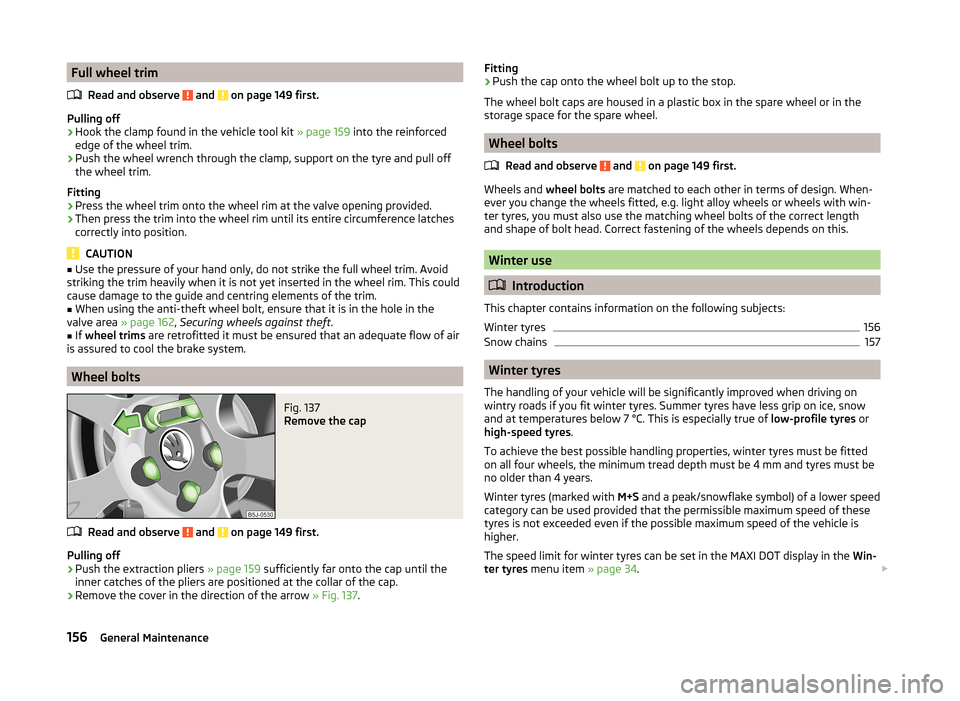
Full wheel trimRead and observe
and on page 149 first.
Pulling off
›
Hook the clamp found in the vehicle tool kit » page 159 into the reinforced
edge of the wheel trim.
›
Push the wheel wrench through the clamp, support on the tyre and pull off
the wheel trim.
Fitting
›
Press the wheel trim onto the wheel rim at the valve opening provided.
›
Then press the trim into the wheel rim until its entire circumference latches
correctly into position.
CAUTION
■ Use the pressure of your hand only, do not strike the full wheel trim. Avoid
striking the trim heavily when it is not yet inserted in the wheel rim. This could
cause damage to the guide and centring elements of the trim.■
When using the anti-theft wheel bolt, ensure that it is in the hole in the
valve area » page 162, Securing wheels against theft .
■
If wheel trims are retrofitted it must be ensured that an adequate flow of air
is assured to cool the brake system.
Wheel bolts
Fig. 137
Remove the cap
Read and observe and on page 149 first.
Pulling off
›
Push the extraction pliers » page 159 sufficiently far onto the cap until the
inner catches of the pliers are positioned at the collar of the cap.
›
Remove the cover in the direction of the arrow » Fig. 137.
Fitting›Push the cap onto the wheel bolt up to the stop.
The wheel bolt caps are housed in a plastic box in the spare wheel or in the
storage space for the spare wheel.
Wheel bolts
Read and observe
and on page 149 first.
Wheels and wheel bolts are matched to each other in terms of design. When-
ever you change the wheels fitted, e.g. light alloy wheels or wheels with win-
ter tyres, you must also use the matching wheel bolts of the correct length
and shape of bolt head. Correct fastening of the wheels depends on this.
Winter use
Introduction
This chapter contains information on the following subjects:
Winter tyres
156
Snow chains
157
Winter tyres
The handling of your vehicle will be significantly improved when driving on
wintry roads if you fit winter tyres. Summer tyres have less grip on ice, snow
and at temperatures below 7 °C. This is especially true of low-profile tyres or
high-speed tyres .
To achieve the best possible handling properties, winter tyres must be fitted
on all four wheels, the minimum tread depth must be 4 mm and tyres must be
no older than 4 years.
Winter tyres (marked with M+S and a peak/snowflake symbol) of a lower speed
category can be used provided that the permissible maximum speed of these
tyres is not exceeded even if the possible maximum speed of the vehicle is
higher.
The speed limit for winter tyres can be set in the MAXI DOT display in the Win-
ter tyres menu item » page 34.
156General Maintenance
Page 159 of 197
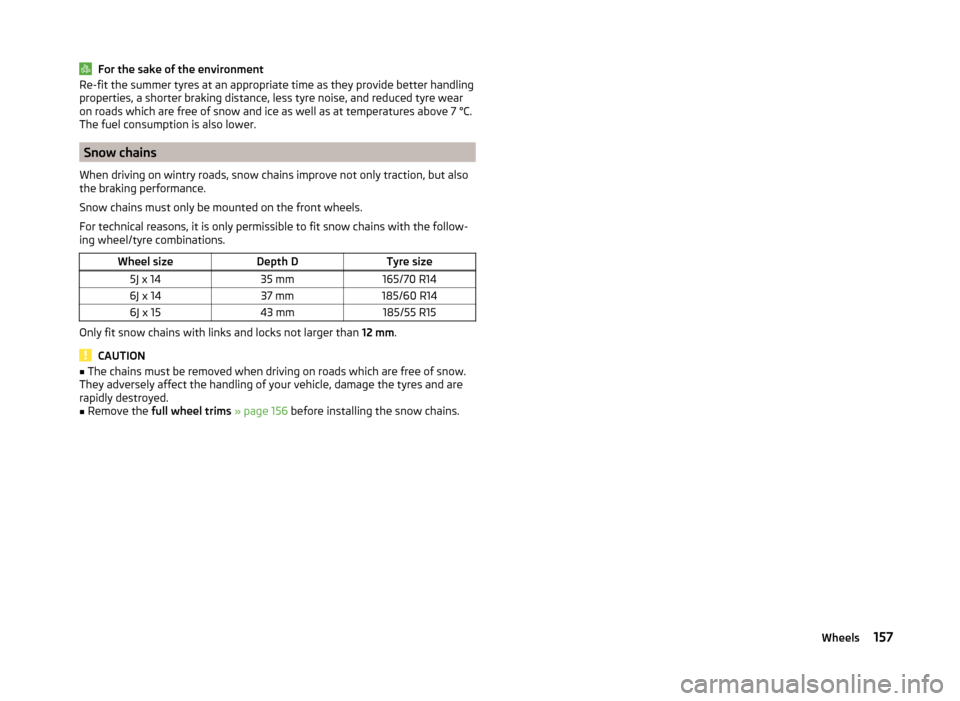
For the sake of the environmentRe-fit the summer tyres at an appropriate time as they provide better handling
properties, a shorter braking distance, less tyre noise, and reduced tyre wear
on roads which are free of snow and ice as well as at temperatures above 7 °C.
The fuel consumption is also lower.
Snow chains
When driving on wintry roads, snow chains improve not only traction, but also
the braking performance.
Snow chains must only be mounted on the front wheels.
For technical reasons, it is only permissible to fit snow chains with the follow-
ing wheel/tyre combinations.
Wheel sizeDepth DTyre size5J x 1435 mm165/70 R146J x 1437 mm185/60 R146J x 1543 mm185/55 R15
Only fit snow chains with links and locks not larger than 12 mm.
CAUTION
■
The chains must be removed when driving on roads which are free of snow.
They adversely affect the handling of your vehicle, damage the tyres and are
rapidly destroyed.■
Remove the full wheel trims » page 156 before installing the snow chains.
157Wheels
Page 160 of 197
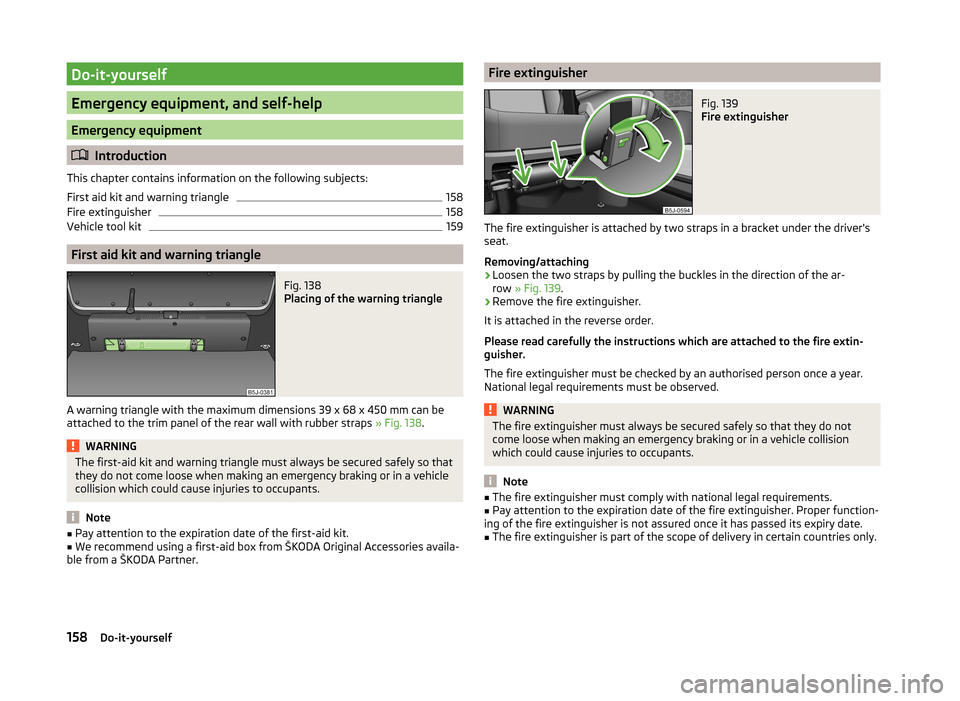
Do-it-yourself
Emergency equipment, and self-help
Emergency equipment
Introduction
This chapter contains information on the following subjects:
First aid kit and warning triangle
158
Fire extinguisher
158
Vehicle tool kit
159
First aid kit and warning triangle
Fig. 138
Placing of the warning triangle
A warning triangle with the maximum dimensions 39 x 68 x 450 mm can be
attached to the trim panel of the rear wall with rubber straps » Fig. 138.
WARNINGThe first-aid kit and warning triangle must always be secured safely so that
they do not come loose when making an emergency braking or in a vehicle
collision which could cause injuries to occupants.
Note
■ Pay attention to the expiration date of the first-aid kit.■We recommend using a first-aid box from ŠKODA Original Accessories availa-
ble from a ŠKODA Partner.Fire extinguisherFig. 139
Fire extinguisher
The fire extinguisher is attached by two straps in a bracket under the driver's seat.
Removing/attaching
›
Loosen the two straps by pulling the buckles in the direction of the ar-
row » Fig. 139 .
›
Remove the fire extinguisher.
It is attached in the reverse order.
Please read carefully the instructions which are attached to the fire extin-
guisher.
The fire extinguisher must be checked by an authorised person once a year.
National legal requirements must be observed.
WARNINGThe fire extinguisher must always be secured safely so that they do not
come loose when making an emergency braking or in a vehicle collision
which could cause injuries to occupants.
Note
■ The fire extinguisher must comply with national legal requirements.■Pay attention to the expiration date of the fire extinguisher. Proper function-
ing of the fire extinguisher is not assured once it has passed its expiry date.■
The fire extinguisher is part of the scope of delivery in certain countries only.
158Do-it-yourself